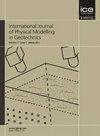Response of a Model Footing Reinforced by Novel Three Dimensional Elements
IF 1.2
4区 工程技术
Q4 ENGINEERING, GEOLOGICAL
International Journal of Physical Modelling in Geotechnics
Pub Date : 2022-02-22
DOI:10.1680/jphmg.21.00055
引用次数: 1
Abstract
In this study, a new three-dimensional (3D) reinforcement element comprising a horizontal ring connected to the vertical legs is introduced. A series of 1g laboratory scale tests were conducted on a circular footing that rested on a sand bed containing planar or new 3D-reinforcements. The effects of depth of first layer, reinforcements configuration number and spacing of layers are reported. Tests were performed on both discrete or contiguously attached elements. The new 3D elements were examined with either upward- or downward-facing legs. An improvement of about 16% was achieved by the upward-legged contiguous 3D elements over the performance delivered by planar contiguous elements. Also, results show that the vertical legs are capable of exerting passive forces on the soil and increasing the stiffness and bearing capacity of the composite system, but the contributory effect is more pronounced for the upward-leg configuration. Finally, 17% and 26% improvements were achieved, respectively, for two planar and two 3D-reinforcement layers when compared with that of a single layer. The concept of planar reinforcement connected to vertical legs, could be adapted for developing a more efficient generation of reinforcement, such as geogrids with vertical ‘legs’, to take advantage of the passive resistance generated by ‘legs’.新型三维单元加固模型基础的响应
在这项研究中,引入了一种新的三维(3D)加固元件,该元件包括连接到垂直支腿的水平环。在圆形基脚上进行了一系列1g实验室规模的试验,该基脚位于含有平面或新三维钢筋的砂床上。报告了第一层深度、钢筋配置数量和层间距的影响。对离散或连续连接的元件进行了测试。新的三维元素是用向上或向下的腿进行检查的。与平面连续元件所提供的性能相比,向上支腿的连续3D元件实现了约16%的改进。此外,结果表明,垂直支腿能够在土壤上施加被动力,并增加复合材料系统的刚度和承载力,但对于向上支腿的配置,这种作用更为明显。最后,与单层相比,两个平面和两个三维加强层分别获得了17%和26%的改进。连接到垂直支腿的平面钢筋的概念可以适用于开发更有效的钢筋生成,例如具有垂直“支腿”的土工格栅,以利用“支脚”产生的被动阻力。
本文章由计算机程序翻译,如有差异,请以英文原文为准。
求助全文
约1分钟内获得全文
求助全文
来源期刊

International Journal of Physical Modelling in Geotechnics
ENGINEERING, GEOLOGICAL-
CiteScore
3.60
自引率
15.80%
发文量
26
期刊介绍:
International Journal of Physical Modelling in Geotechnics contains the latest research and analysis in all areas of physical modelling at any scale, including modelling at single gravity and at multiple gravities on a centrifuge, shaking table and pressure chamber testing and geoenvironmental experiments.
 求助内容:
求助内容: 应助结果提醒方式:
应助结果提醒方式:


